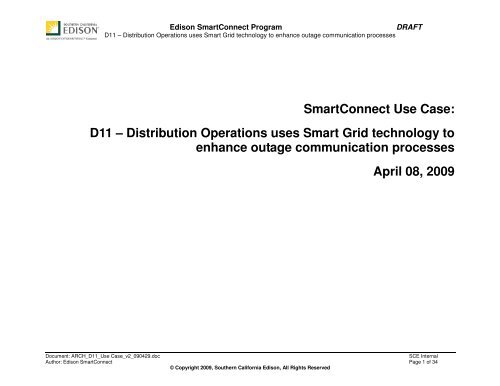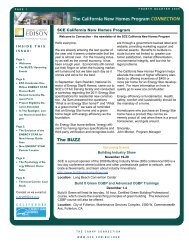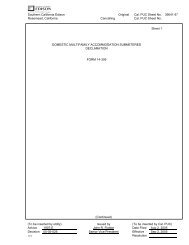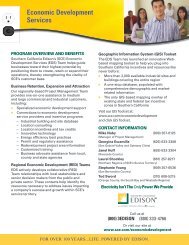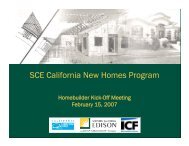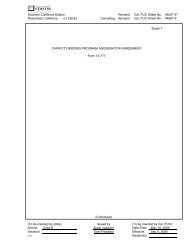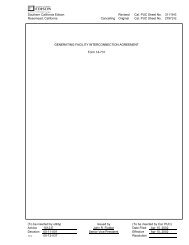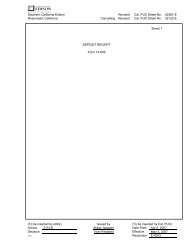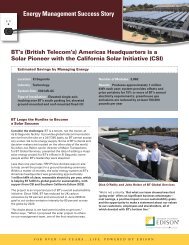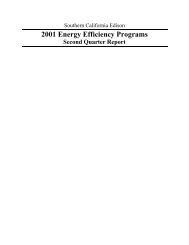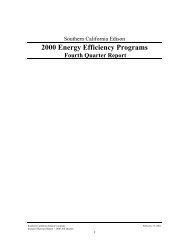SmartConnect Use Case: D11 - Southern California Edison
SmartConnect Use Case: D11 - Southern California Edison
SmartConnect Use Case: D11 - Southern California Edison
You also want an ePaper? Increase the reach of your titles
YUMPU automatically turns print PDFs into web optimized ePapers that Google loves.
<strong>Edison</strong> <strong>SmartConnect</strong> Program DRAFT<br />
<strong>D11</strong> – Distribution Operations uses Smart Grid technology to enhance outage communication processes<br />
<strong>SmartConnect</strong> <strong>Use</strong> <strong>Case</strong>:<br />
<strong>D11</strong> – Distribution Operations uses Smart Grid technology to<br />
enhance outage communication processes<br />
April 08, 2009<br />
Document: ARCH_<strong>D11</strong>_<strong>Use</strong> <strong>Case</strong>_v2_090429.doc SCE Internal<br />
Author: <strong>Edison</strong> <strong>SmartConnect</strong> Page 1 of 34<br />
© Copyright 2009, <strong>Southern</strong> <strong>California</strong> <strong>Edison</strong>, All Rights Reserved
Document History<br />
Revision History<br />
Revision<br />
Number<br />
Revision<br />
Date<br />
<strong>Edison</strong> <strong>SmartConnect</strong> Program DRAFT<br />
<strong>D11</strong> – Distribution Operations uses Smart Grid technology to enhance outage communication processes<br />
Revised / Reviewed<br />
By<br />
Summary of Changes Changes<br />
marked<br />
(#) (yymmdd) (Name) (Describe change) (Y/N)<br />
0.1 081107 Kevin Clampitt Initial draft from workshop on October 22, 2008 N<br />
0.2 090330 Kevin Clampitt Second draft N<br />
0.3 090429 Kevin Clampitt Third draft N<br />
Approvals<br />
This document requires following approvals.<br />
Name Title<br />
Bryan Lambird Project Manager, Planning & Policy Support<br />
Stephen D. Scott Manager, Customer Experience<br />
Percy Haralson Manager, Field Technologies<br />
Document: ARCH_<strong>D11</strong>_<strong>Use</strong> <strong>Case</strong>_v2_090429.doc SCE Internal<br />
Author: <strong>Edison</strong> <strong>SmartConnect</strong> Page 2 of 34<br />
© Copyright 2009, <strong>Southern</strong> <strong>California</strong> <strong>Edison</strong>, All Rights Reserved
Contents<br />
<strong>Edison</strong> <strong>SmartConnect</strong> Program DRAFT<br />
<strong>D11</strong> – Distribution Operations uses Smart Grid technology to enhance outage communication processes<br />
1. <strong>Use</strong> <strong>Case</strong> Description............................................................................................. 4<br />
1.1 <strong>Use</strong> <strong>Case</strong> Title ................................................................................................................................ 4<br />
1.2 <strong>Use</strong> <strong>Case</strong> Summary........................................................................................................................ 4<br />
1.3 <strong>Use</strong> <strong>Case</strong> Detailed Narrative .......................................................................................................... 4<br />
1.4 Business Rules and Assumptions .................................................................................................. 7<br />
2. Actors..................................................................................................................... 8<br />
3. Step by Step analysis of each Scenario............................................................... 10<br />
3.1 Primary Scenario: Field worker communicates unplanned outage restoration status to update<br />
distribution operations and customer contact channels .......................................................................... 10<br />
3.1.1 Steps for this scenario........................................................................................................... 11<br />
3.2 Scenario: Field worker communicates planned outage restoration status to update distribution<br />
operations and customer contact channels............................................................................................. 16<br />
3.2.1 Steps for this scenario........................................................................................................... 16<br />
4. Requirements....................................................................................................... 19<br />
4.1 Functional Requirements.............................................................................................................. 19<br />
4.2 Non-functional Requirements....................................................................................................... 25<br />
5. <strong>Use</strong> <strong>Case</strong> Models (optional) ................................................................................. 26<br />
5.1 Diagrams ...................................................................................................................................... 27<br />
6. <strong>Use</strong> <strong>Case</strong> Issues .................................................................................................. 30<br />
7. Glossary ............................................................................................................... 31<br />
8. References........................................................................................................... 33<br />
9. Bibliography (optional).......................................................................................... 34<br />
Document: ARCH_<strong>D11</strong>_<strong>Use</strong> <strong>Case</strong>_v2_090429.doc SCE Internal<br />
Author: <strong>Edison</strong> <strong>SmartConnect</strong> Page 3 of 34<br />
© Copyright 2009, <strong>Southern</strong> <strong>California</strong> <strong>Edison</strong>, All Rights Reserved
<strong>Edison</strong> <strong>SmartConnect</strong> Program DRAFT<br />
<strong>D11</strong> – Distribution Operations uses Smart Grid technology to enhance outage communication processes<br />
1. <strong>Use</strong> <strong>Case</strong> Description<br />
1.1 <strong>Use</strong> <strong>Case</strong> Title<br />
Distribution Operations uses Smart Grid technology to enhance outage communication processes.<br />
1.2 <strong>Use</strong> <strong>Case</strong> Summary<br />
This use case describes how the Consolidated Mobile Solution (CMS) could improve communications between SCE and its customers during<br />
outages. CMS empowers field workers to communicate the status of trouble orders and estimated restoration times (ERT) to SCE back office<br />
systems from the field in real-time. This updated outage status information would be accessible to customers who contact SCE via telephone or<br />
the company website. Customers would also have the option to receive updates from SCE via proactive e-mails, text messages, or phone calls.<br />
The business value of these improved communication processes includes reduced costs and increased customer benefits.<br />
1.3 <strong>Use</strong> <strong>Case</strong> Detailed Narrative<br />
Outages represent a significant source of customer frustration and dissatisfaction. One factor contributing to this dissatisfaction is when the utility<br />
is unable to provide satisfactory information on the expected duration of the outage to customers. During outages 30% of customers call more<br />
than once because they either are not satisfied with the information they received during the first call, or because SCE exceeded the estimated<br />
restoration time (ERT). Proactively communicating outage status and restoration information would improve customer satisfaction scores and<br />
reduce the number of outage-related customer calls.<br />
The current process field workers use to communicate outage status information to back office systems could be improved. This process involves<br />
radioing outage status information from the field to the Distribution Operations Center (DOC). The DOC then manually enters the information into<br />
the Outage Management System (OMS), which populates other back office systems and updates the Outage Alert Notes (OAN). This manual<br />
process can cause both delays and inaccuracies in the information made available to Customer Services Representatives (CSRs), the utility<br />
website, and other outbound customer communication channels. Improvements to this process could enable CSRs, the Voice Response Unit<br />
(VRU) and SCE.com to provide customers with more accurate and up-to-date information on estimated restoration times and outage status.<br />
This use case describes how a Consolidated Mobile Solution (CMS) could improve communications between SCE and its customers during<br />
outages. CMS empowers field workers to communicate outage status (including ERT) to SCE back office systems from the field in real-time. At<br />
each of the following critical workflow points, the field worker would use a “Status Button” on the CMS device to automatically update the outage<br />
status in OMS, the Outage Alert Note, and other back office systems. The following represent the critical steps where an automatic update would<br />
occur:<br />
Document: ARCH_<strong>D11</strong>_<strong>Use</strong> <strong>Case</strong>_v2_090429.doc SCE Internal<br />
Author: <strong>Edison</strong> <strong>SmartConnect</strong> Page 4 of 34<br />
© Copyright 2009, <strong>Southern</strong> <strong>California</strong> <strong>Edison</strong>, All Rights Reserved
<strong>Edison</strong> <strong>SmartConnect</strong> Program DRAFT<br />
<strong>D11</strong> – Distribution Operations uses Smart Grid technology to enhance outage communication processes<br />
1. Acknowledge receipt of the trouble order.<br />
2. Indicate “En Route” to the outage site.<br />
3. CMS sends message that the field worker is “On Site” when the GPS-enabled vehicle senses it is in the vicinity of the outage site.<br />
4. Assess work requirements and determine the ERT.<br />
5. Validate or update the ERT based on work progress.<br />
6. Complete work and restore power.<br />
Since the Outage Alert Note (OAN) would be updated automatically from the field via CMS, customers could then have the option of receiving<br />
outage status updates from SCE via proactive e-mails, text messages, or phone calls. Customers could customize their personal communication<br />
profiles, specifying the preferred communications channels and messaging frequency. For example, a customer might only want to receive one<br />
phone call with an estimated restoration time (ERT). The same customer might be willing to receive more frequent text messages if there is an<br />
update to the ERT (e.g. the power will be restored an hour earlier than initially reported). Customers could also receive these communications to<br />
more than one location. This might include multiple mobile phones for a multi-person household, or a secondary notification to a relative. For<br />
business customers this could include other customer-authorized personnel or agents.<br />
Business Value<br />
The benefits of using Smart Grid technology for the outage communication processes include the following:<br />
1. Reduced Costs:<br />
a. Avoided Outage Calls:<br />
i. First Calls: During planned outages SCE can reduce the number of customer calls by proactively communicating planned<br />
outage information prior to the outage date. During unplanned outages SCE can reduce the number of calls if the<br />
<strong>SmartConnect</strong> meter sends “last gasp” messages to the In-Home Display (IHD).<br />
ii. Multiple Calls: During outages 30% of customers call more than once because they either are not satisfied with the<br />
information they received during the first call, or because SCE exceeded the estimated restoration time (ERT). By<br />
providing more accurate and current outage status information during their first call and by proactively communicating<br />
outage status during the outage, SCE can reduce the number of times customers call more than once.<br />
b. Labor Efficiencies: Using CMS to automatically update the Outage Alert Note (OAN) would reduce manual processing activities<br />
at the Distribution Operations Center. Timely and accurate updates to OANs would also make Customer Service Representatives<br />
(CSR) and the Voice Response Unit (VRU) more effective and efficient with customer calls. Finally, the restoration verification<br />
process would make field workers more productive. Verifying restoration prior to departure from the outage site would eliminate<br />
the need to make a second trip if power was not restored (see use case D4).<br />
Document: ARCH_<strong>D11</strong>_<strong>Use</strong> <strong>Case</strong>_v2_090429.doc SCE Internal<br />
Author: <strong>Edison</strong> <strong>SmartConnect</strong> Page 5 of 34<br />
© Copyright 2009, <strong>Southern</strong> <strong>California</strong> <strong>Edison</strong>, All Rights Reserved
<strong>Edison</strong> <strong>SmartConnect</strong> Program DRAFT<br />
<strong>D11</strong> – Distribution Operations uses Smart Grid technology to enhance outage communication processes<br />
c. Resource Flexibility: Customers who call SCE and are satisfied with the information they obtain are typically more understanding<br />
in terms of the outage length. This could permit greater operational flexibility during storms or other outage periods when SCE is<br />
highly resource constrained.<br />
d. Customer Notifications: SCE may save on expenses related to informing customers of planned outages via traditional means<br />
such as door hangers, mailings, outbound calls, knocking on doors, etc.<br />
2. Increased Customer Benefits:<br />
a. Non-SCE Outages: SCE could offer its communications channel to third parties as a service. One example is a local cable<br />
company that needs to notify customers of outage statuses.<br />
b. Safety Notifications: SCE could broadcast weather warnings and other notifications to promote customer safety.<br />
c. Promotions: SCE could promote awareness of programs and services during an outage (movie tickets, solar energy<br />
advertisements, etc.).<br />
d. Improved Accuracy and Timeliness of Information: Customers who call SCE during an outage often call more than once. On<br />
average, those who call a second time have lower customer satisfaction. Thus, providing more accurate ERT information during<br />
the customer’s initial call would increase customer satisfaction. In addition, by proactively calling customers with updated outage<br />
status and ERT information, SCE can also increase customer satisfaction.<br />
e. Communications Flexibility: Customers would have an option to choose the communications channels for outage-related<br />
messages, and to authorize secondary notifications to others (e.g. family members, authorized employees for commercial<br />
accounts, etc.).<br />
f. Planning around Outages: Customers with better outage status information could plan around the outages. Residential<br />
customers might want to leave home for errands. Likewise, businesses with better information could mitigate productivity losses<br />
by more effectively managing their operations and workforce.<br />
Document: ARCH_<strong>D11</strong>_<strong>Use</strong> <strong>Case</strong>_v2_090429.doc SCE Internal<br />
Author: <strong>Edison</strong> <strong>SmartConnect</strong> Page 6 of 34<br />
© Copyright 2009, <strong>Southern</strong> <strong>California</strong> <strong>Edison</strong>, All Rights Reserved
<strong>Edison</strong> <strong>SmartConnect</strong> Program DRAFT<br />
<strong>D11</strong> – Distribution Operations uses Smart Grid technology to enhance outage communication processes<br />
1.4 Business Rules and Assumptions<br />
• The full vision and high level requirements for the Consolidated Mobile Solution (CMS) are captured across use cases D10 and <strong>D11</strong>.<br />
However, individual requirements are independent of one another for the purpose of a phased implementation of CMS.<br />
• OMS is the source to the other back office systems that require outage status information.<br />
• The process described in this use case for communicating Outage Alert Note (OAN) updates to customers is the same for planned<br />
outages and unplanned outages. The only difference is timing (i.e. advanced notifications is provided to customers in the case of planned<br />
outages.)<br />
• CMS is a common field tool for both Trouble Workers and Line Crew personnel; different capabilities may be available to these different<br />
users based on job classification, but the system itself is fundamentally the same.<br />
• Only those customers who have opted-in to receive proactive notifications from the utility receive the OAN updates (for both planned and<br />
unplanned outages.<br />
• Planned outages would all receive proactive prior notice communications from SCE, advising them of the upcoming planned outage.<br />
• In the event of transmission or substation outages, the Dispatcher, rather than CMS, manually updates the status of work orders and<br />
OAN, determines estimated restoration times (ERT), and performs updates to OMS.<br />
• Customers do not require perfect estimates of restoration time.<br />
• Messages are sent to the customer in near real-time.<br />
• In-Home Displays (IHD) are widely available with high customer adoption rates, and are thus the default option for customer notifications.<br />
However, other communication channel options are also available, including e-mail, text messages and phone calls.<br />
• IHD are able to receive and display outage-related messages in the absence of grid power.<br />
• Estimated restoration times (ERTs) are only performed by field personnel for non-storm outages. During storms, ERTs are generated by<br />
the Storm Centers rather than field personnel.<br />
Document: ARCH_<strong>D11</strong>_<strong>Use</strong> <strong>Case</strong>_v2_090429.doc SCE Internal<br />
Author: <strong>Edison</strong> <strong>SmartConnect</strong> Page 7 of 34<br />
© Copyright 2009, <strong>Southern</strong> <strong>California</strong> <strong>Edison</strong>, All Rights Reserved
2. Actors<br />
<strong>Edison</strong> <strong>SmartConnect</strong> Program DRAFT<br />
<strong>D11</strong> – Distribution Operations uses Smart Grid technology to enhance outage communication processes<br />
Describe the primary and secondary actors involved in the use case. This might include all the people (their job), systems, databases,<br />
organizations, and devices involved in or affected by the Function (e.g. operators, system administrators, customer, end users, service personnel,<br />
executives, meter, real-time database, ISO, power system). Actors listed for this use case should be copied from the global actors list to ensure<br />
consistency across all use cases.<br />
Actor Name Actor Type (person,<br />
device, system etc.)<br />
Consolidated Mobile Solution<br />
(CMS)<br />
Actor Description<br />
System A collection of remote field tools, mobile software, and the associated<br />
communications network infrastructure used by field workers. CMS shall be<br />
configured to be role-based, providing varying functionalities depending on the user.<br />
Customer Person Residential, commercial and governmental energy user that has a contract with the<br />
utility to receive electrical service from the utility and has an advanced meter installed.<br />
The customer may or may not participate in programs provided by the utility including<br />
pricing events, load control, distributed generation, or outage notifications.<br />
Customer Relationship<br />
Management System (CRM)<br />
System The Customer Relationship Management System (CRM) manages SCE’s contact<br />
with its customers. CRM stores customer information and is used to support the<br />
various processes involving customer contact. This information can be accessed,<br />
entered or updated by certain employees and back office systems.<br />
Dispatcher Person In case of an outage (power failure) the Dispatcher looks at the OMS system to<br />
determine the problem and sends Trouble Workers to investigate and perform<br />
repairs.<br />
Line Crew Persons Performs manual operation of field devices, repair and construction work; works on<br />
power system equipment in the field, as instructed by work orders and as authorized<br />
by the Distribution Operator or Crew Dispatcher to fix a fault; informs Crew Dispatcher<br />
or Distribution Operators of progress.<br />
Outage Alert Note (OAN) Notification Outage Alert Notes are notes that are available to customers via Customer Service<br />
Representatives, the Voice Response Unit (VRU) and the utility website. The note<br />
includes the estimated restoration time (ERT), other status information such as the<br />
field worker status (e.g. dispatched, en-route, or on site), and possible outage causes.<br />
These notes are currently created manually. CSRs and the VRU can provide this<br />
information to customers who call SCE. OANs are generated in OMS, and may be<br />
updated by field workers via CMS. CMS would transmit updates to the Outage<br />
Management System (OMS), which updates the OAN and transmits the updated<br />
Document: ARCH_<strong>D11</strong>_<strong>Use</strong> <strong>Case</strong>_v2_090429.doc SCE Internal<br />
Author: <strong>Edison</strong> <strong>SmartConnect</strong> Page 8 of 34<br />
© Copyright 2009, <strong>Southern</strong> <strong>California</strong> <strong>Edison</strong>, All Rights Reserved
<strong>Edison</strong> <strong>SmartConnect</strong> Program DRAFT<br />
<strong>D11</strong> – Distribution Operations uses Smart Grid technology to enhance outage communication processes<br />
Actor Name Actor Type (person,<br />
device, system etc.)<br />
Outage Management System<br />
(OMS)<br />
Actor Description<br />
information to the Customer Service System (CSS). This information would be<br />
available to Customer Service Representatives for customer calls. It would also be<br />
used as a basis for other outbound customer communications.<br />
System A distribution management system which uses an analysis engine to identify the<br />
location of outages. It correlates end-point outages and infers root causes by<br />
identifying common failure points grouped upstream, using information from the GIS,<br />
CSS, SCADA and <strong>SmartConnect</strong> systems, and customer calls. An OMS helps in<br />
reducing outage duration and assists with restoration plans. Determination of outage<br />
locations is based on the system's knowledge of the power system topology.<br />
Status Button The Status Button is a shortcut button on the Consolidated Mobile System device<br />
(CMS) that Line Crews and Troublemen use to communicate work order and outage<br />
information from the field to utility back office systems. For example, the Trouble<br />
Worker would use the Status Button to communicate “En Route” status, and provide<br />
an estimated time of arrival at the job site. It would also be used to provide updates<br />
to the estimated restoration time (ERT). The “Status Button” may include a drop<br />
down menu for quick information entry.<br />
Trouble Worker Person Field personnel who act as “first responders” to field issues which need to be worked<br />
on or evaluated to determine the crews necessary to perform the work.<br />
Work Assignment<br />
Coordinator (WAC)<br />
Work Management System<br />
(WMS)<br />
Person The individual within Distribution Construction and Maintenance (DC&M) that<br />
determines ERTs and schedules Line Crews to perform outage restoration work.<br />
Troublemen can typically perform 80% of non-storm outage restoration work, with the<br />
remainder performed by Line Crews. During storm-related outages the Line Crews<br />
perform the majority of restoration work. If the Trouble Worker cannot restore power<br />
by himself, he estimates the Line Crew requirements (time and number of personnel)<br />
and communicates this to the WAC. Communication between the Troublemen and<br />
WAC is currently performed via radio, which results in information having to be<br />
manually entered into OMS. This costs both time and resources, delays the<br />
information from being received into the CSS system and, ultimately, causes delays<br />
in information being made available to CSRs and customers.<br />
System The Work Management System (WMS) generates, prioritizes and schedules work<br />
orders, and delivers them to the field worker via CMS. SAP is the system that<br />
currently performs this function at SCE.<br />
Document: ARCH_<strong>D11</strong>_<strong>Use</strong> <strong>Case</strong>_v2_090429.doc SCE Internal<br />
Author: <strong>Edison</strong> <strong>SmartConnect</strong> Page 9 of 34<br />
© Copyright 2009, <strong>Southern</strong> <strong>California</strong> <strong>Edison</strong>, All Rights Reserved
<strong>Edison</strong> <strong>SmartConnect</strong> Program DRAFT<br />
<strong>D11</strong> – Distribution Operations uses Smart Grid technology to enhance outage communication processes<br />
3. Step by Step analysis of each Scenario<br />
Describe steps that implement the scenario. The first scenario should be classified as either a “Primary” Scenario or an “Alternate” Scenario by<br />
starting the title of the scenario with either the work “Primary” or “Alternate”. A scenario that successfully completes without exception or relying<br />
heavily on steps from another scenario should be classified as Primary; all other scenarios should be classified as “Alternate”. If there is more<br />
than one scenario (set of steps) that is relevant, make a copy of the following section (all of 3.1, including 3.1.1 and tables) and fill out the<br />
additional scenarios.<br />
3.1 Primary Scenario: Field worker communicates unplanned outage restoration status to<br />
update distribution operations and customer contact channels<br />
This scenario describes how field workers use the Consolidated Mobile Solution (CMS) device to improve communications between SCE and its<br />
customers during unplanned outages. CMS empowers field workers to communicate the status of trouble orders and estimated restoration times<br />
(ERT) to SCE back office systems from the field in real-time. This updated outage status information is accessible to customers who contact SCE<br />
via telephone or the company website. Customers also have the option of receiving outage status updates from SCE via proactive e-mails, text<br />
messages, or phone calls. The business value of these improved communication processes includes reduced costs and increased customer<br />
benefits.<br />
Triggering Event Primary Actor Pre-Condition Post-Condition<br />
(Identify the name of the event that start<br />
the scenario)<br />
Outage Management System<br />
(OMS) confirms there is an<br />
outage.<br />
(Identify the actor whose point-of-view is<br />
primarily used to describe the steps)<br />
(Identify any pre-conditions or actor states<br />
necessary for the scenario to start)<br />
(Identify the post-conditions or significant<br />
results required to consider the scenario<br />
complete)<br />
OMS Service is restored.<br />
Document: ARCH_<strong>D11</strong>_<strong>Use</strong> <strong>Case</strong>_v2_090429.doc SCE Internal<br />
Author: <strong>Edison</strong> <strong>SmartConnect</strong> Page 10 of 34<br />
© Copyright 2009, <strong>Southern</strong> <strong>California</strong> <strong>Edison</strong>, All Rights Reserved
<strong>Edison</strong> <strong>SmartConnect</strong> Program DRAFT<br />
<strong>D11</strong> – Distribution Operations uses Smart Grid technology to enhance outage communication processes<br />
3.1.1 Steps for this scenario<br />
Describe the normal sequence of events that is required to complete the scenario.<br />
Step # Actor Description of the Step Additional Notes<br />
# What actor, either primary or<br />
secondary is responsible for<br />
the activity in this step?<br />
Describe the actions that take place in this step. The step should be described<br />
in active, present tense.<br />
1 Customer Customer receives notification from SCE via the In-Home<br />
Display (IHD), confirming SCE is aware of the outage and<br />
providing a qualitative measure of the outage magnitude.<br />
Elaborate on any additional description or<br />
value of the step to help support the<br />
descriptions. Short notes on architecture<br />
challenges, etc. may also be noted in this<br />
column.<br />
The customer’s IHD has battery<br />
power, enabling it to receive a “last<br />
gasp” notification directly from the<br />
<strong>SmartConnect</strong> meter. Records of all<br />
such individual customer<br />
communications are stored in the<br />
Customer Relationship Management<br />
System (CRM).<br />
The default communications channel<br />
is the IHD. However, customers<br />
shall also have the option to preselect<br />
other communications<br />
channels (e-mail, text message or<br />
phone call).<br />
The qualitative measure of outage<br />
magnitude will indicate whether it is<br />
an area, neighborhood, or isolated<br />
problem.<br />
This initial outage confirmation<br />
notification shall include a telephone<br />
number that customers may call for<br />
additional outage information. For<br />
example, a VRU might be able to<br />
Document: ARCH_<strong>D11</strong>_<strong>Use</strong> <strong>Case</strong>_v2_090429.doc SCE Internal<br />
Author: <strong>Edison</strong> <strong>SmartConnect</strong> Page 11 of 34<br />
© Copyright 2009, <strong>Southern</strong> <strong>California</strong> <strong>Edison</strong>, All Rights Reserved
<strong>Edison</strong> <strong>SmartConnect</strong> Program DRAFT<br />
<strong>D11</strong> – Distribution Operations uses Smart Grid technology to enhance outage communication processes<br />
Step # Actor Description of the Step Additional Notes<br />
2 Dispatcher Dispatcher assigns trouble order and dispatches the Trouble<br />
Worker via CMS.<br />
3 Trouble Worker Trouble Worker acknowledges receipt of trouble order via the<br />
CMS device, moving the trouble order to “Dispatched” status<br />
and automatically updating the Outage Alert Note (OAN) and<br />
other back office systems.<br />
4 Trouble Worker Trouble Worker begins travel to job site and changes trouble<br />
order status to “En Route” via CMS device. The OAN and other<br />
back office systems are automatically updated.<br />
provide customers with estimated<br />
restoration times (ERT), if available,<br />
outage magnitude, and other<br />
information about the trouble order<br />
status (i.e. field worker “En Route” or<br />
“On Site”.)<br />
See use case D10 for further<br />
discussion of CMS. The trouble<br />
order would also include any relevant<br />
information the Dispatcher knows<br />
about the outage.<br />
The Trouble Worker acknowledges<br />
receipt of the trouble order via the<br />
CMS device. The CMS device<br />
includes a “Status Button” that<br />
facilitates rapid and simple status<br />
updates. The trouble order is moved<br />
to “Dispatched” status. The change<br />
of status is sent to the back office<br />
systems (e.g. OMS, CSS, WMS and<br />
CRM), and the Outage Alert Note<br />
(OAN) is automatically updated. The<br />
OAN is available to Customer<br />
Service Reps (CSRs), Voice<br />
Response Unit (VRU) and SCE<br />
website. This step does not<br />
necessarily mean the Trouble<br />
Worker is en route. It simply means<br />
he has received the trouble order.<br />
The Trouble Worker updates the<br />
trouble order status via the CMS<br />
“Status Button”. The trouble order<br />
status update is automatically sent<br />
by CMS to the back office systems<br />
(e.g. OMS, CSS, WMS and CRM),<br />
and the OAN is automatically<br />
Document: ARCH_<strong>D11</strong>_<strong>Use</strong> <strong>Case</strong>_v2_090429.doc SCE Internal<br />
Author: <strong>Edison</strong> <strong>SmartConnect</strong> Page 12 of 34<br />
© Copyright 2009, <strong>Southern</strong> <strong>California</strong> <strong>Edison</strong>, All Rights Reserved
<strong>Edison</strong> <strong>SmartConnect</strong> Program DRAFT<br />
<strong>D11</strong> – Distribution Operations uses Smart Grid technology to enhance outage communication processes<br />
Step # Actor Description of the Step Additional Notes<br />
5 Customer If subscribed, the customer receives message indicating<br />
Trouble Worker is “En Route” to the outage location.<br />
6 CMS CMS changes trouble order status to “On Site” when the<br />
vehicle’s GPS detects it is within proximity of the job site.<br />
7 Customer If subscribed, the customer receives message indicating<br />
Trouble Worker is “On Site” at the outage location.<br />
8 Trouble Worker Trouble Worker arrives “On Site”, identifies the problem and<br />
attempts to complete the necessary repairs.<br />
8.1 Trouble Worker If the Trouble Worker is able to restore power he updates the<br />
trouble order status and proceeds to Step 16.<br />
8.2 Trouble Worker If the Trouble Worker cannot perform the restoration, he<br />
updates CMS by assessing the repair requirements, preparing<br />
a materials list, estimating the repair time, initiating a new work<br />
order for Line Crew dispatch, and determining an estimated<br />
restoration time (ERT). CMS transmits this information to the<br />
back office systems.<br />
updated. If the Trouble Worker does<br />
not update the status to “En Route”<br />
CMS will send a status update when<br />
the truck detects it is within proximity<br />
of the outage location (Step 6).<br />
Communication sent according to<br />
pre-defined customer preferences.<br />
During outages affecting an<br />
individual customer, the Trouble<br />
Worker would continue the current<br />
practice of calling the customer while<br />
“en route”.<br />
“On Site” refers to the outage site, as<br />
determined by OMS.<br />
Communication sent according to<br />
pre-defined customer preferences.<br />
Work Management System (WMS)<br />
would determine or adjust the ERT<br />
based on factors such as the outage<br />
location, traffic, number of workers<br />
on call, historical average response<br />
and repair times, and Line Crew<br />
response rates. The Trouble Worker<br />
could access this application via<br />
CMS to determine the ERT in the<br />
field. He would be able to override<br />
this system-generated ERT based on<br />
his knowledge of specific<br />
circumstances in the field.<br />
The new work order would be linked<br />
Document: ARCH_<strong>D11</strong>_<strong>Use</strong> <strong>Case</strong>_v2_090429.doc SCE Internal<br />
Author: <strong>Edison</strong> <strong>SmartConnect</strong> Page 13 of 34<br />
© Copyright 2009, <strong>Southern</strong> <strong>California</strong> <strong>Edison</strong>, All Rights Reserved
<strong>Edison</strong> <strong>SmartConnect</strong> Program DRAFT<br />
<strong>D11</strong> – Distribution Operations uses Smart Grid technology to enhance outage communication processes<br />
Step # Actor Description of the Step Additional Notes<br />
9 Customer If subscribed, the customer receives a message indicating the<br />
updated ERT.<br />
10 Work Assignment<br />
Coordinator (WAC)<br />
Work Assignment Coordinator confirms Line Crew availability<br />
and schedules work order.<br />
11 Line Crew Line Crew arrives on site and updates the estimated ERT via<br />
CMS.<br />
12 Customer If subscribed, the customer receives a message indicating the<br />
updated ERT.<br />
13 Line Crew Line Crew continues to validate and update the estimated ERT<br />
via CMS, as necessary, as they perform the outage restoration<br />
work.<br />
to the original trouble order.<br />
These messages are only sent to<br />
customers that have subscribed to<br />
receive them.<br />
ERTs for would only be estimated for<br />
non-storm outages.<br />
All ERT updates are automatically<br />
sent by CMS to the back office<br />
systems (OMS, CSS, WMS and<br />
CRM), and the OAN is automatically<br />
updated. CRM then sends the<br />
customer a status update message<br />
according to their predefined<br />
preferences.<br />
These messages are only sent to<br />
customers that have subscribed to<br />
receive them.<br />
All ERT updates are automatically<br />
sent by CMS to the back office<br />
systems (OMS, CSS, WMS and<br />
CRM), and the OAN is automatically<br />
updated. CRM then sends the<br />
customer a status update message<br />
according to their predefined<br />
preferences.<br />
CMS would automatically prompt the<br />
field worker to validate the ERT 30<br />
minutes prior to the ERT. For<br />
example, if the ERT is 1:30PM, CMS<br />
would prompt the field worker to<br />
validate the ERT at 1:00PM.<br />
Document: ARCH_<strong>D11</strong>_<strong>Use</strong> <strong>Case</strong>_v2_090429.doc SCE Internal<br />
Author: <strong>Edison</strong> <strong>SmartConnect</strong> Page 14 of 34<br />
© Copyright 2009, <strong>Southern</strong> <strong>California</strong> <strong>Edison</strong>, All Rights Reserved
<strong>Edison</strong> <strong>SmartConnect</strong> Program DRAFT<br />
<strong>D11</strong> – Distribution Operations uses Smart Grid technology to enhance outage communication processes<br />
Step # Actor Description of the Step Additional Notes<br />
14 Customer If subscribed, the customer receives message(s) indicating the<br />
updated ERT.<br />
15 Line Crew Line Crew completes work and updates work order status via<br />
CMS.<br />
16 CMS CMS updates the OAN and back office systems (OMS, CSS,<br />
CRM), and OMS performs the <strong>SmartConnect</strong>-enabled<br />
restoration verification as described in use case D4 in which<br />
OMS pings nearby meters (known to be out) to verify<br />
restoration.<br />
17 Customer Customer receives “Power Restored” message which lists the<br />
outage cause and duration, and an apology.<br />
If power is not restored, the customer<br />
contacts utility by replying to the email<br />
or text notification, or via the<br />
website or telephone number listed<br />
on the initial outage message (from<br />
Step 1).<br />
Document: ARCH_<strong>D11</strong>_<strong>Use</strong> <strong>Case</strong>_v2_090429.doc SCE Internal<br />
Author: <strong>Edison</strong> <strong>SmartConnect</strong> Page 15 of 34<br />
© Copyright 2009, <strong>Southern</strong> <strong>California</strong> <strong>Edison</strong>, All Rights Reserved
<strong>Edison</strong> <strong>SmartConnect</strong> Program DRAFT<br />
<strong>D11</strong> – Distribution Operations uses Smart Grid technology to enhance outage communication processes<br />
3.2 Scenario: Field worker communicates planned outage restoration status to update<br />
distribution operations and customer contact channels<br />
This scenario describes the SCE communications process during planned outages. This includes communications between SCE and the<br />
customer, and between SCE field crews and SCE back office systems. Prior to a planned outage, SCE proactively communicates planned outage<br />
information to the customer via the In-Home Display (IHD). During the planned outage, CMS empowers field workers to communicate the status<br />
of work orders and estimated restoration times (ERT) to SCE back office systems from the field in real-time. This updated outage status<br />
information is accessible to customers who contact SCE via telephone or the company website. Customers also have the option of receiving<br />
outage status updates from SCE via proactive e-mails, text messages, or phone calls. The business value of these improved communication<br />
processes includes reduced costs and increased customer benefits.<br />
Triggering Event Primary Actor Pre-Condition Post-Condition<br />
(Identify the name of the event that start<br />
the scenario)<br />
SCE determines there is a need<br />
for a planned outage.<br />
3.2.1 Steps for this scenario<br />
(Identify the actor whose point-of-view is<br />
primarily used to describe the steps)<br />
(Identify any pre-conditions or actor states<br />
necessary for the scenario to start)<br />
(Identify the post-conditions or significant<br />
results required to consider the scenario<br />
complete)<br />
OMS Service is restored.<br />
Describe the normal sequence of events that is required to complete the scenario.<br />
Step # Actor Description of the Step Additional Notes<br />
# What actor, either primary<br />
or secondary is responsible<br />
for the activity in this step?<br />
Describe the actions that take place in this step. The step should be<br />
described in active, present tense.<br />
1 Customer Customer receives advance notification from SCE of the<br />
planned outage event, via the In-Home Display (IHD).<br />
Elaborate on any additional description or value of the<br />
step to help support the descriptions. Short notes on<br />
architecture challenges, etc. may also be noted in this<br />
column.<br />
The advanced notification includes the<br />
date and time of the planned outage, as<br />
well as a brief explanation of the reason for<br />
Document: ARCH_<strong>D11</strong>_<strong>Use</strong> <strong>Case</strong>_v2_090429.doc SCE Internal<br />
Author: <strong>Edison</strong> <strong>SmartConnect</strong> Page 16 of 34<br />
© Copyright 2009, <strong>Southern</strong> <strong>California</strong> <strong>Edison</strong>, All Rights Reserved
<strong>Edison</strong> <strong>SmartConnect</strong> Program DRAFT<br />
<strong>D11</strong> – Distribution Operations uses Smart Grid technology to enhance outage communication processes<br />
Step # Actor Description of the Step Additional Notes<br />
2 Work Assignment<br />
Coordinator (WAC)<br />
Work Assignment Coordinator confirms Line Crew<br />
availability and schedules work order.<br />
3 Line Crew Line Crew arrives on site, initiates planned outage, and<br />
updates the estimated restoration time (ERT) via CMS.<br />
4 Outage Management<br />
System (OMS)<br />
Outage Management System (OMS) confirms the onset of<br />
the planned outage and provides a qualitative measure of<br />
outage magnitude to the customer.<br />
the planned outage.<br />
Customers may opt to receive notifications<br />
from SCE via an outbound phone call<br />
(VRU), e-mail, text message, or the In-<br />
Home Display. The default<br />
communications channel is the IHD.<br />
Records of all such individual customer<br />
communications are stored in the<br />
Customer Relationship Management<br />
System (CRM).<br />
All ERT updates are automatically sent by<br />
CMS to the back office systems (OMS,<br />
CSS, WMS and CRM), and the OAN is<br />
automatically updated. CRM then sends<br />
the customer a status update message<br />
according to their predefined preferences.<br />
The customer’s IHD has battery power,<br />
enabling it to receive a “last gasp”<br />
notification directly from the <strong>SmartConnect</strong><br />
meter.<br />
This initial outage confirmation notification<br />
shall include a telephone number that<br />
customers may call for additional outage<br />
information. For example, a VRU might be<br />
able to provide customers with ERT, if<br />
available, and outage magnitude.<br />
The qualitative measure of outage<br />
magnitude will indicate whether it is a<br />
neighborhood, area, or isolated outage.<br />
Document: ARCH_<strong>D11</strong>_<strong>Use</strong> <strong>Case</strong>_v2_090429.doc SCE Internal<br />
Author: <strong>Edison</strong> <strong>SmartConnect</strong> Page 17 of 34<br />
© Copyright 2009, <strong>Southern</strong> <strong>California</strong> <strong>Edison</strong>, All Rights Reserved
<strong>Edison</strong> <strong>SmartConnect</strong> Program DRAFT<br />
<strong>D11</strong> – Distribution Operations uses Smart Grid technology to enhance outage communication processes<br />
Step # Actor Description of the Step Additional Notes<br />
5 Customer If subscribed, the customer receives a message confirming<br />
the onset of the planned outage and indicating the updated<br />
ERT.<br />
6 Line Crew Line Crew continues to validate and update the estimated<br />
ERT via CMS, as necessary, as they perform the planned<br />
outage work.<br />
7 Customer If subscribed, the customer receives message(s) indicating<br />
the updated ERT.<br />
8 Line Crew Line Crew completes work and updates work order status<br />
via CMS.<br />
9 CMS CMS updates the OAN and back office systems (OMS,<br />
CSS, CRM).<br />
10 OMS OMS performs the <strong>SmartConnect</strong>-enabled restoration<br />
verification as described in use case D4 in which OMS<br />
pings nearby meters (known to be out) to verify restoration.<br />
11 Customer Customer receives “Power Restored” message which lists<br />
the outage duration, and an apology.<br />
All ERT updates are automatically sent by<br />
CMS to the back office systems (OMS,<br />
CSS, WMS and CRM), and the OAN is<br />
automatically updated. CRM then sends<br />
the customer a status update message<br />
according to their predefined preferences.<br />
CMS would automatically prompt the field<br />
worker to validate the ERT 30 minutes<br />
prior to the ERT. For example, if the ERT<br />
is 1:30PM, CMS would prompt the field<br />
worker to validate the ERT at 1:00PM.<br />
If power is not restored, the customer<br />
contacts utility by replying to the e-mail or<br />
text notification, or via the website or<br />
telephone number listed on the initial<br />
outage message (from Step 1).<br />
Document: ARCH_<strong>D11</strong>_<strong>Use</strong> <strong>Case</strong>_v2_090429.doc SCE Internal<br />
Author: <strong>Edison</strong> <strong>SmartConnect</strong> Page 18 of 34<br />
© Copyright 2009, <strong>Southern</strong> <strong>California</strong> <strong>Edison</strong>, All Rights Reserved
4. Requirements<br />
<strong>Edison</strong> <strong>SmartConnect</strong> Program DRAFT<br />
<strong>D11</strong> – Distribution Operations uses Smart Grid technology to enhance outage communication processes<br />
Detail the Functional, Non-functional and Business Requirements generated from the workshop in the tables below. If applicable list the<br />
associated use case scenario and step.<br />
4.1 Functional Requirements<br />
Req.<br />
ID<br />
Functional Requirements Associated<br />
Scenario #<br />
1 The Customer Relationship Management System (CRM) shall log confirmed outages for<br />
a given customer.<br />
(if applicable)<br />
Associated<br />
Step #<br />
(if applicable)<br />
1 & 2 Scenario 1: 1<br />
Scenario 2: 4<br />
2 SCE shall be able to send customer notifications to acknowledge the outage. 1 & 2 Scenario 1: 1<br />
3 SCE shall be able to send customer notifications that include an indication of outage<br />
magnitude (e.g. whether the outage was an area, neighborhood or isolated problem).<br />
4 SCE shall be able to send customer notifications that include a phone number for<br />
customers to call for additional outage information.<br />
5 In-Home Displays (IHDs) shall be able to receive “last gasp” messages from<br />
<strong>SmartConnect</strong> meters for customer viewing.<br />
Scenario 2: 4<br />
1 & 2 Scenario 1: 1<br />
Scenario 2: 1,4<br />
1 & 2 Scenario 1: 1<br />
Scenario 2: 4<br />
1 & 2 Scenario 1: 1<br />
Scenario 2: 4<br />
6 IHDs shall be able to receive notifications for planned outages in advance of the outage<br />
event.<br />
2 1<br />
7 Planned outage notifications shall include the planned outage date and time. 2 1<br />
8 Planned outage notifications shall include the reason for the planned outage. 2 1<br />
9 In the absence of power to the <strong>SmartConnect</strong> meter, the IHD shall be capable of<br />
receiving messages directly from an alternative source (cell relay, wide area broadband,<br />
etc.).<br />
1 & 2 Scenario 1: 1,5,7,<br />
9,12,14,17<br />
Scenario 2: 1,5,7,<br />
11<br />
Document: ARCH_<strong>D11</strong>_<strong>Use</strong> <strong>Case</strong>_v2_090429.doc SCE Internal<br />
Author: <strong>Edison</strong> <strong>SmartConnect</strong> Page 19 of 34<br />
© Copyright 2009, <strong>Southern</strong> <strong>California</strong> <strong>Edison</strong>, All Rights Reserved
Req.<br />
ID<br />
<strong>Edison</strong> <strong>SmartConnect</strong> Program DRAFT<br />
<strong>D11</strong> – Distribution Operations uses Smart Grid technology to enhance outage communication processes<br />
Functional Requirements Associated<br />
Scenario #<br />
10 SCE shall be able to send customer notifications that include estimated restoration times<br />
(ERT).<br />
11 SCE shall be able to send customer notifications for any status changes or updates to<br />
Outage Alert Notices (OANs).<br />
12 The IHD shall be the default channel for outage communications to customers (e.g. if the<br />
customer does not customize their communications preferences, all outage<br />
communications will go to the IHD).<br />
13 SCE shall be able to send customer notifications according to customer communication<br />
preferences (as stored in CRM).<br />
14 CRM shall provide suggested customer “notification bundles” for customers to subscribe<br />
to.<br />
15 CRM “notification bundles” shall be based on expected preferences for different<br />
customer groups (based on surveys or, if available, historical customer selection data).<br />
16 CRM shall allow outbound customer communication preferences to be configurable by<br />
channel type. For example, a customer may be willing to receive multiple frequent text<br />
messages, but may only want one phone call. Alternatively, a customer may not want to<br />
receive calls at inconvenient times, but they may be willing to receive an e-mail or text<br />
message at these times.<br />
17 CRM shall allow outbound customer communication preferences to be configurable by<br />
notification type. For example, a customer may want to receive a notification only when<br />
power has been restored (but no other ERT updates).<br />
(if applicable)<br />
Associated<br />
Step #<br />
(if applicable)<br />
1 & 2 Scenario1: 9,12,14<br />
Scenario 2: 5,7<br />
1 & 2 Scenario 1: 5,7,<br />
12,14,17<br />
Scenario 2: 5,7,11<br />
1 & 2 Scenario 1: 1,5,7,<br />
9,12,14,17<br />
Scenario 2: 1,5,7,<br />
11<br />
1 & 2 Scenario 1: 1,5,7,<br />
9,12,14,17<br />
Scenario 2: 1,5,7,<br />
Document: ARCH_<strong>D11</strong>_<strong>Use</strong> <strong>Case</strong>_v2_090429.doc SCE Internal<br />
Author: <strong>Edison</strong> <strong>SmartConnect</strong> Page 20 of 34<br />
© Copyright 2009, <strong>Southern</strong> <strong>California</strong> <strong>Edison</strong>, All Rights Reserved<br />
11<br />
1 & 2 Scenario 1: 1,5,7,<br />
9,12,14,17<br />
Scenario 2: 1,5,7,<br />
11<br />
1 & 2 Scenario 1: 1,5,7,<br />
9,12,14,17<br />
Scenario 2: 1,5,7,<br />
11<br />
1 & 2 Scenario 1: 1,5,7,<br />
9,12,14,17<br />
Scenario 2: 1,5,7,<br />
11<br />
1 & 2 Scenario 1: 1,5,7,<br />
9,12,14,17<br />
Scenario 2: 1,5,7,
Req.<br />
ID<br />
<strong>Edison</strong> <strong>SmartConnect</strong> Program DRAFT<br />
<strong>D11</strong> – Distribution Operations uses Smart Grid technology to enhance outage communication processes<br />
Functional Requirements Associated<br />
Scenario #<br />
18 CRM shall allow customers to select multiple channels for receiving communications<br />
from SCE (text message, e-mail, IHD, or phone call).<br />
19 CRM shall allow for customer notification preferences to be updated through a web<br />
interface.<br />
20 CRM shall allow for customer notification preferences to be updated through a Customer<br />
Service Representative (CSR) interface.<br />
(if applicable)<br />
Associated<br />
Step #<br />
(if applicable)<br />
Document: ARCH_<strong>D11</strong>_<strong>Use</strong> <strong>Case</strong>_v2_090429.doc SCE Internal<br />
Author: <strong>Edison</strong> <strong>SmartConnect</strong> Page 21 of 34<br />
© Copyright 2009, <strong>Southern</strong> <strong>California</strong> <strong>Edison</strong>, All Rights Reserved<br />
11<br />
1 & 2 Scenario 1: 1,5,7,<br />
9,12,14,17<br />
Scenario 2: 1,5,7,<br />
11<br />
1 & 2 Scenario 1: 1,5,7,<br />
9,12,14,17<br />
Scenario 2: 1,5,7,<br />
11<br />
1 & 2 Scenario 1: 1,5,7,<br />
9,12,14,17<br />
Scenario 2: 1,5,7,<br />
11<br />
21 CRM shall log occurrences of customer notifications via all channels. 1 & 2 Scenario 1: 1,5,7,<br />
9,12,14,17<br />
22 Customer Account Representatives shall be able to subscribe to OAN notifications for<br />
commercial and industrial customers.<br />
Scenario 2: 1,5,7,<br />
11<br />
1 & 2 Scenario 1: 1,5,7,<br />
9,12,14,17<br />
Scenario 2: 1,5,7,<br />
23 CRM shall store the customer preferences for outbound communications from SCE. 1 & 2 Scenario 1: 1,5,7,<br />
9,12,14,17<br />
24 The Outage Management System (OMS) shall be integrated with the Customer<br />
Relationship Management System (CRM) to enable delivery of customer notifications<br />
11<br />
Scenario 2: 1,5,7,<br />
11<br />
1 & 2 Scenario 1: 1,5,7,<br />
9,12,14,17
Req.<br />
ID<br />
<strong>Edison</strong> <strong>SmartConnect</strong> Program DRAFT<br />
<strong>D11</strong> – Distribution Operations uses Smart Grid technology to enhance outage communication processes<br />
Functional Requirements Associated<br />
Scenario #<br />
(if applicable)<br />
Associated<br />
Step #<br />
(if applicable)<br />
according to customer communication method preferences. Scenario 2: 1,5,7,<br />
25 The Consolidated Mobile Solution (CMS) shall contain a “Status Button” that field<br />
workers can utilize to initiate quick updates to the trouble order (including ERT status).<br />
26 CMS shall be integrated with OMS such that it possesses all information entered into<br />
CMS by field workers in the field.<br />
27 Field workers shall be required to update the trouble order status (acknowledgement of<br />
trouble order received, en route to job-site, etc.) and ERT estimates via CMS.<br />
28 CMS shall be able to update trouble order status (including ERT estimates) in SCE back<br />
office systems (OMS, CSS, WMS and CRM).<br />
29 CMS shall route all trouble orders and ERT updates to relevant back office systems<br />
(OMS, CSS, WMS and CRM).<br />
Document: ARCH_<strong>D11</strong>_<strong>Use</strong> <strong>Case</strong>_v2_090429.doc SCE Internal<br />
Author: <strong>Edison</strong> <strong>SmartConnect</strong> Page 22 of 34<br />
© Copyright 2009, <strong>Southern</strong> <strong>California</strong> <strong>Edison</strong>, All Rights Reserved<br />
10, 11<br />
1 & 2 Scenario 1: 3,4,8,<br />
11,13<br />
Scenario 2: 3,6<br />
1 & 2 Scenario 1: 3,4,6,<br />
8,8.2,11,13,15<br />
Scenario 2: 3,6,8<br />
1 & 2 Scenario 1: 3,4,8,<br />
11,13,15<br />
Scenario 2: 3,6,8<br />
1 & 2 Scenario 1: 3,4,6,<br />
8,8.2,11,13,16<br />
Scenario 2: 3,6,9,<br />
10<br />
1 & 2 Scenario 1: 3,4,6,<br />
8,8.2,11,13,16<br />
Scenario 2: 3,6,9,<br />
10<br />
30 OMS shall be able to receive data from CMS. 1 & 2 Scenario 1: 3,4,6,<br />
8,8.2,11,13,16<br />
Scenario 2: 3,6,9,<br />
10<br />
31 OMS shall be able to process data received from OMS (i.e. update the OANs). 1 & 2 Scenario 1: 3,4,6,<br />
8,8.2,11,13,16<br />
32 Outage Alert Notes (OANs) shall be automatically updated when field workers update<br />
trouble orders via CMS.<br />
Scenario 2: 3,6,9,<br />
10<br />
1 & 2 Scenario 1: 3,4,6,<br />
8,8.2,11,13,16
Req.<br />
ID<br />
<strong>Edison</strong> <strong>SmartConnect</strong> Program DRAFT<br />
<strong>D11</strong> – Distribution Operations uses Smart Grid technology to enhance outage communication processes<br />
Functional Requirements Associated<br />
Scenario #<br />
33 Updated OANs shall be available for CSRs and the VRU. This is necessary to enable<br />
SCE to provide current outage information to customers.<br />
(if applicable)<br />
Associated<br />
Step #<br />
(if applicable)<br />
Scenario 2: 3,6,9,<br />
10<br />
1 & 2 Scenario 1: 3,4,6,<br />
8,8.2,11,13,16<br />
Scenario 2: 3,6,9,<br />
10<br />
34 The CMS GPS function shall be able to detect when field workers are in the job-site<br />
vicinity.<br />
1 6 & 11<br />
35 CMS shall be able to automatically update the OAN to “On Site” when the field worker is<br />
detected in the job-site vicinity.<br />
1 6 & 11<br />
36 CMS shall be able to generate new work orders. 1 8.2<br />
37 CMS-generated work orders shall be linked to an original trouble order (if applicable). 1 8.2<br />
38 The Work Management System (WMS) shall consider crew availability when calculating<br />
ERTs.<br />
1 8.2<br />
39 WMS shall be able to consider material availability when calculating ERTs. 1 8.2<br />
40 WMS shall be able to consider standard hours for repairs when calculating ERTs. 1 8.2<br />
41 WMS shall be able to consider historical average response and repair times when<br />
calculating ERTs.<br />
1 8.2<br />
42 WMS shall be able to consider travel time when calculating ERTs. 1 8.2<br />
43 WMS shall be able to consider other local factors when calculating ERTs. 1 8.2<br />
44 CMS shall enable Trouble Workers to override WMS-calculated ERTs. 1 8.2<br />
45 CMS shall be able to automatically prompt field workers to validate the ERT 30 minutes<br />
prior to the ERT.<br />
46 The utility shall be able to communicate ERT updates to customers only when the<br />
change is greater than 30 minutes.<br />
47 SCE shall be able to send “power restored” notifications to customers upon verification<br />
of service restoration.<br />
1 & 2 Scenario 1: 13<br />
Scenario 2: 6<br />
1 & 2 Scenario 1: 14<br />
Scenario 2: 7<br />
1 & 2 Scenario 1: 11<br />
Document: ARCH_<strong>D11</strong>_<strong>Use</strong> <strong>Case</strong>_v2_090429.doc SCE Internal<br />
Author: <strong>Edison</strong> <strong>SmartConnect</strong> Page 23 of 34<br />
© Copyright 2009, <strong>Southern</strong> <strong>California</strong> <strong>Edison</strong>, All Rights Reserved
Req.<br />
ID<br />
<strong>Edison</strong> <strong>SmartConnect</strong> Program DRAFT<br />
<strong>D11</strong> – Distribution Operations uses Smart Grid technology to enhance outage communication processes<br />
Functional Requirements Associated<br />
Scenario #<br />
48 “Power restored” notifications shall include outage summary information (e.g. outage<br />
cause and duration).<br />
49 Outage communications shall be automated (to support paging and other internal<br />
communication capabilities).<br />
(if applicable)<br />
Associated<br />
Step #<br />
(if applicable)<br />
Scenario 2: 11<br />
1 & 2 Scenario 1: 17<br />
Scenario 2: 11<br />
1 & 2 All<br />
Document: ARCH_<strong>D11</strong>_<strong>Use</strong> <strong>Case</strong>_v2_090429.doc SCE Internal<br />
Author: <strong>Edison</strong> <strong>SmartConnect</strong> Page 24 of 34<br />
© Copyright 2009, <strong>Southern</strong> <strong>California</strong> <strong>Edison</strong>, All Rights Reserved
<strong>Edison</strong> <strong>SmartConnect</strong> Program DRAFT<br />
<strong>D11</strong> – Distribution Operations uses Smart Grid technology to enhance outage communication processes<br />
4.2 Non-functional Requirements<br />
Req.<br />
ID<br />
Non-Functional Requirements Associated<br />
Scenario #<br />
1 CMS shall be able to transmit trouble order and ERT information to relevant back office<br />
systems on a real-time basis (within 10 minutes).<br />
2 The Dispatcher shall be able to transmit trouble orders and other job-site specific<br />
information to the Trouble Worker on a real-time basis (within less than one minute).<br />
3 The Customer Relationship Management System (CRM) shall enable customers to<br />
select among multiple communications channels.<br />
4 CRM shall enable multiple receivers of notifications (e.g. designated commercial<br />
customer employees or agents, residential customer family members, etc.).<br />
(if applicable)<br />
Associated Step<br />
#<br />
(if applicable)<br />
1 & 2 Scenario 1: 3,4,6,8,<br />
11,13,15<br />
Scenario 2: 3,6,8<br />
1 2<br />
1 & 2 Scenario 1: 1,5,7,<br />
12,14,17<br />
Scenario 2: 1, 5,7,<br />
11<br />
1 & 2 Scenario 1: 1,5,7,<br />
12,14,17<br />
Scenario 2: 1, 5,7,<br />
11<br />
Document: ARCH_<strong>D11</strong>_<strong>Use</strong> <strong>Case</strong>_v2_090429.doc SCE Internal<br />
Author: <strong>Edison</strong> <strong>SmartConnect</strong> Page 25 of 34<br />
© Copyright 2009, <strong>Southern</strong> <strong>California</strong> <strong>Edison</strong>, All Rights Reserved
<strong>Edison</strong> <strong>SmartConnect</strong> Program DRAFT<br />
<strong>D11</strong> – Distribution Operations uses Smart Grid technology to enhance outage communication processes<br />
5. <strong>Use</strong> <strong>Case</strong> Models (optional)<br />
This section is used by the architecture team to detail information exchange, actor interactions and sequence diagrams<br />
Document: ARCH_<strong>D11</strong>_<strong>Use</strong> <strong>Case</strong>_v2_090429.doc SCE Internal<br />
Author: <strong>Edison</strong> <strong>SmartConnect</strong> Page 26 of 34<br />
© Copyright 2009, <strong>Southern</strong> <strong>California</strong> <strong>Edison</strong>, All Rights Reserved
5.1 Diagrams<br />
<strong>Edison</strong> <strong>SmartConnect</strong> Program DRAFT<br />
<strong>D11</strong> – Distribution Operations uses Smart Grid technology to enhance outage communication processes<br />
Document: ARCH_<strong>D11</strong>_<strong>Use</strong> <strong>Case</strong>_v2_090429.doc SCE Internal<br />
Author: <strong>Edison</strong> <strong>SmartConnect</strong> Page 27 of 34<br />
© Copyright 2009, <strong>Southern</strong> <strong>California</strong> <strong>Edison</strong>, All Rights Reserved
<strong>Edison</strong> <strong>SmartConnect</strong> Program DRAFT<br />
<strong>D11</strong> – Distribution Operations uses Smart Grid technology to enhance outage communication processes<br />
<strong>Use</strong> <strong>Case</strong> <strong>D11</strong> – Scenario 3.1 Field worker communicates unplanned outage restoration status to update<br />
distribution operations and customer contact channels<br />
Line Crew Trouble Worker Dispatcher / WAC CMS<br />
Customer<br />
Data<br />
Transfer<br />
Step 1, Data A Step 5 Step 7<br />
Receives outage<br />
notification from<br />
SCE<br />
(via IHD or other<br />
channel)<br />
Step 2, Data B<br />
Assigns trouble<br />
order and<br />
dispatches Trouble<br />
Worker<br />
(via CMS)<br />
Step 3, Data C<br />
Acknowledges<br />
receipt of trouble<br />
order<br />
(via CMS)<br />
Data A<br />
Acknowledges outage<br />
Measure of outage<br />
magnitude<br />
Contact phone number<br />
Receives “En<br />
Route” message, if<br />
applicable<br />
(via IHD or other<br />
channel)<br />
Step 4, Data C<br />
Departs for job site<br />
and updates<br />
trouble order to<br />
“En Route”<br />
(via CMS)<br />
Data B<br />
Sends trouble order<br />
Sends other relevant<br />
outage information<br />
Receives “On Site”<br />
message, if<br />
applicable<br />
(via IHD or other<br />
channel)<br />
Step 6, Data C<br />
Detects Trouble<br />
Worker near job<br />
site; changes<br />
trouble order to<br />
“On Site”<br />
Step 8<br />
Arrives on site and<br />
attempts to restore<br />
service<br />
Data C<br />
CMS updates trouble order in<br />
OMS, OAN and other back<br />
office systems.<br />
Restoration<br />
achieved?<br />
Receives “Power<br />
Restored”<br />
message<br />
(via IHD or other<br />
channel)<br />
Document: ARCH_<strong>D11</strong>_<strong>Use</strong> <strong>Case</strong>_v2_090429.doc SCE Internal<br />
Author: <strong>Edison</strong> <strong>SmartConnect</strong> Page 28 of 34<br />
© Copyright 2009, <strong>Southern</strong> <strong>California</strong> <strong>Edison</strong>, All Rights Reserved<br />
No<br />
Yes<br />
Data D<br />
Sends work order to WAC<br />
Sends repair requirements,<br />
materials list, estimated repair<br />
time and ERT<br />
Steps 9, 12 & 14 Step 17, Data G<br />
Receives updated<br />
ERT message<br />
(via IHD or other<br />
channel)<br />
Step 8.1, Data D<br />
Prepare Line Crew<br />
work order<br />
(via CMS)<br />
Step 10, Data E<br />
Confirms Line<br />
Crew availability<br />
and schedules<br />
work order<br />
(via CMS)<br />
Arrives on site;<br />
and updates ERT<br />
(via CMS)<br />
Data E<br />
Sends work order to Line Crew<br />
Sends other relevant outage<br />
information<br />
Performs<br />
restoration work;<br />
updates ERT<br />
periodically<br />
(via CMS)<br />
Data F<br />
CMS updates work order and<br />
ERT in OMS, OAN and other<br />
back office systems<br />
Step 16<br />
Updates OAN and<br />
back office<br />
systems; verifies<br />
restoration<br />
(via OMS)<br />
Step 8.2, Data C<br />
Updates trouble<br />
order<br />
(via CMS)<br />
Step 11, Data F Step 13, Data F Step 15, Data F<br />
Completes<br />
restoration work<br />
and updates<br />
trouble order<br />
(via CMS)<br />
Data G<br />
Notification includes outage<br />
cause, duration and apology
<strong>Edison</strong> <strong>SmartConnect</strong> Program DRAFT<br />
<strong>D11</strong> – Distribution Operations uses Smart Grid technology to enhance outage communication processes<br />
<strong>Use</strong> <strong>Case</strong> <strong>D11</strong> – Scenario 3.2 Field worker communicates planned outage restoration status to update<br />
distribution operations and customer contact channels<br />
Customer<br />
Line Crew Dispatcher / WAC CMS<br />
Outage<br />
Management<br />
System<br />
Data<br />
Transfer<br />
Step 1, Data A Step 5, Data D<br />
Receives<br />
advanced outage<br />
notification from<br />
SCE<br />
(via IHD or other<br />
channel)<br />
Step 2, Data B<br />
Confirms Line<br />
Crew availability<br />
and schedules<br />
work order<br />
Step 3, Data C<br />
Arrives on site,<br />
initiates planned<br />
outage and<br />
updates Estimated<br />
Restoration Time<br />
(via CMS)<br />
Step 4<br />
Confirms start of<br />
planned outage<br />
and sends<br />
measure of outage<br />
magnitude<br />
Data A<br />
Planned outage data and<br />
time<br />
Explanation / reason for<br />
planned outage<br />
Data B<br />
Receives outage<br />
confirmation<br />
message and<br />
updated ERT (via<br />
IHD or other<br />
channel)<br />
Sends work order to Line<br />
Crew<br />
Sends other relevant<br />
outage information<br />
Data C<br />
Step 6, Data C<br />
Updates work<br />
order status<br />
(via CMS)<br />
CMS updates work order and<br />
ERT in OMS, OAN and other<br />
back office systems<br />
Step 7 Step 11, Data E<br />
Receives updated<br />
ERT message<br />
(via IHD or other<br />
channel)<br />
Data D<br />
Outage confirmation notification<br />
Telephone number for<br />
customers to call for outage<br />
information, ERT, and<br />
magnitude<br />
Step 8, Data C<br />
Completes work<br />
order and updates<br />
status (via CMS)<br />
Data E<br />
Notification includes<br />
outage duration and<br />
apology<br />
Step 9, Data C<br />
Updates OAN and<br />
back office<br />
systems; verifies<br />
restoration<br />
(via OMS)<br />
Performs<br />
<strong>SmartConnect</strong><br />
enabled<br />
restoration<br />
verification<br />
Receives “Power<br />
Restored”<br />
message<br />
(via IHD or other<br />
channel)<br />
Document: ARCH_<strong>D11</strong>_<strong>Use</strong> <strong>Case</strong>_v2_090429.doc SCE Internal<br />
Author: <strong>Edison</strong> <strong>SmartConnect</strong> Page 29 of 34<br />
© Copyright 2009, <strong>Southern</strong> <strong>California</strong> <strong>Edison</strong>, All Rights Reserved<br />
Step 10
6. <strong>Use</strong> <strong>Case</strong> Issues<br />
<strong>Edison</strong> <strong>SmartConnect</strong> Program DRAFT<br />
<strong>D11</strong> – Distribution Operations uses Smart Grid technology to enhance outage communication processes<br />
Capture any issues with the use case. Specifically, these are issues that are not resolved and help the use case reader understand the constraints<br />
or unresolved factors that have an impact of the use case scenarios and their realization.<br />
Issue<br />
Describe the issue as well as any potential impacts to the use case.<br />
Need to overcome the potential reluctance of field workers to update work order statuses via CMS.<br />
Need to develop capability within the Work Management System (WMS) to automatically calculate the estimated restoration time based on<br />
historical experience and the ability to capture real-time field conditions.<br />
Document: ARCH_<strong>D11</strong>_<strong>Use</strong> <strong>Case</strong>_v2_090429.doc SCE Internal<br />
Author: <strong>Edison</strong> <strong>SmartConnect</strong> Page 30 of 34<br />
© Copyright 2009, <strong>Southern</strong> <strong>California</strong> <strong>Edison</strong>, All Rights Reserved
7. Glossary<br />
<strong>Edison</strong> <strong>SmartConnect</strong> Program DRAFT<br />
<strong>D11</strong> – Distribution Operations uses Smart Grid technology to enhance outage communication processes<br />
Insert the terms and definitions relevant to this use case. Please ensure that any glossary item added to this list should be included in the global<br />
glossary to ensure consistency between use cases.<br />
Term Definition<br />
Customer Service<br />
Representative<br />
(CSR)<br />
Customer Service<br />
System (CSS)<br />
Distribution<br />
Operations Center<br />
(DOC)<br />
Estimated<br />
Restoration Time<br />
(ERT)<br />
Glossary<br />
Staff employed by the utility who respond to customer complaints, outage<br />
notifications, and customer requests to activate, modify and/or terminate delivery of<br />
service. CSR also enroll customers in utility-sponsored programs and answer<br />
questions related to customer energy consumption and cost data. Many off-cycle<br />
reading, billing, work orders and diagnostics requests are initiated by CSRs in<br />
response to customer contact.<br />
A system responsible for producing customer invoices from accurate "bill ready"<br />
<strong>SmartConnect</strong> meter readings. Invoices can be produced periodically (on cycle) or<br />
as a result of a specific event (off cycle). Accurate bills require accurate and timely<br />
information from the <strong>SmartConnect</strong> meters. The system is responsible for storing<br />
customer specific information like site data, <strong>SmartConnect</strong> meter numbers and<br />
rates and program participation. The system also tracks and manages customer<br />
invoices and payments.<br />
Maintains customer contact information, calculates and formats customer bills,<br />
receives, and applies payments for individual accounts. The system is responsible<br />
for storing customer information such as site data, meter number, rates, and<br />
program participation(s).<br />
The Distribution Operations Center (DOC) is the location at which Operators<br />
monitor the distribution system, perform remote actions (i.e. operating switches),<br />
and take other actions on circuits to preserve grid stability. Dispatchers at the DOC<br />
dispatch Trouble Workers to perform trouble shooting and repair work. Work<br />
Assignment Coordinators assign and dispatch Line Crews to<br />
The estimate of the time required to restore power to the customer.<br />
Field Worker Field personnel who perform planned maintenance and emergency repair activities<br />
on distribution assets. This could include Trouble Workers, Line Crews or E-Crew<br />
Document: ARCH_<strong>D11</strong>_<strong>Use</strong> <strong>Case</strong>_v2_090429.doc SCE Internal<br />
Author: <strong>Edison</strong> <strong>SmartConnect</strong> Page 31 of 34<br />
© Copyright 2009, <strong>Southern</strong> <strong>California</strong> <strong>Edison</strong>, All Rights Reserved
In-Home Display<br />
(IHD)<br />
Voice Response<br />
Unit (VRU)<br />
<strong>Edison</strong> <strong>SmartConnect</strong> Program DRAFT<br />
<strong>D11</strong> – Distribution Operations uses Smart Grid technology to enhance outage communication processes<br />
personnel.<br />
This device will enable customers to view their usage and cost data within their<br />
home or business. Data will be passed to this device via the <strong>SmartConnect</strong> Meter.<br />
Only utility-approved devices will be able to connect to the <strong>SmartConnect</strong> network<br />
and receive data and communications from SCE.<br />
The device shall be located at the customer site and be able to receive usage and<br />
cost information, text messages, and other energy information from the<br />
<strong>SmartConnect</strong> meter via Home-Area Network (HAN) communications. The device<br />
must meet SCE requirements (for communication to the HAN) to enable these<br />
capabilities.<br />
Automated telephone answering system responsible for first tier of response to<br />
customer outage calls.<br />
Document: ARCH_<strong>D11</strong>_<strong>Use</strong> <strong>Case</strong>_v2_090429.doc SCE Internal<br />
Author: <strong>Edison</strong> <strong>SmartConnect</strong> Page 32 of 34<br />
© Copyright 2009, <strong>Southern</strong> <strong>California</strong> <strong>Edison</strong>, All Rights Reserved
8. References<br />
<strong>Edison</strong> <strong>SmartConnect</strong> Program DRAFT<br />
<strong>D11</strong> – Distribution Operations uses Smart Grid technology to enhance outage communication processes<br />
Reference any prior work (intellectual property of companies or individuals) used in the preparation of this use case<br />
Document: ARCH_<strong>D11</strong>_<strong>Use</strong> <strong>Case</strong>_v2_090429.doc SCE Internal<br />
Author: <strong>Edison</strong> <strong>SmartConnect</strong> Page 33 of 34<br />
© Copyright 2009, <strong>Southern</strong> <strong>California</strong> <strong>Edison</strong>, All Rights Reserved
<strong>Edison</strong> <strong>SmartConnect</strong> Program DRAFT<br />
<strong>D11</strong> – Distribution Operations uses Smart Grid technology to enhance outage communication processes<br />
9. Bibliography (optional)<br />
Provide a list of related reading, standards, etc. that the use case reader may find helpful.<br />
Document: ARCH_<strong>D11</strong>_<strong>Use</strong> <strong>Case</strong>_v2_090429.doc SCE Internal<br />
Author: <strong>Edison</strong> <strong>SmartConnect</strong> Page 34 of 34<br />
© Copyright 2009, <strong>Southern</strong> <strong>California</strong> <strong>Edison</strong>, All Rights Reserved


